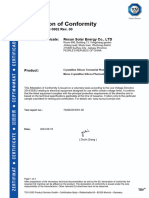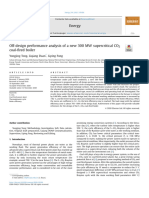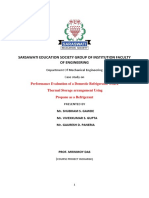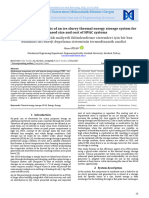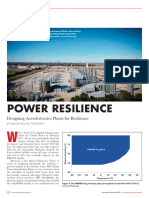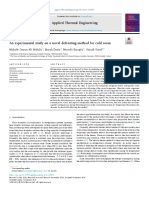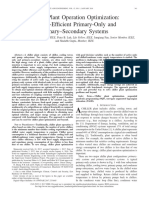TES Without Ice: by Daniel Pare, P.E., Associate Member ASHRAE and Stephane Bilodeau, PH.D., P.E., Member ASHRAE
TES Without Ice: by Daniel Pare, P.E., Associate Member ASHRAE and Stephane Bilodeau, PH.D., P.E., Member ASHRAE
Uploaded by
Pranay SawantCopyright:
Available Formats
TES Without Ice: by Daniel Pare, P.E., Associate Member ASHRAE and Stephane Bilodeau, PH.D., P.E., Member ASHRAE
TES Without Ice: by Daniel Pare, P.E., Associate Member ASHRAE and Stephane Bilodeau, PH.D., P.E., Member ASHRAE
Uploaded by
Pranay SawantOriginal Title
Copyright
Available Formats
Share this document
Did you find this document useful?
Is this content inappropriate?
Copyright:
Available Formats
TES Without Ice: by Daniel Pare, P.E., Associate Member ASHRAE and Stephane Bilodeau, PH.D., P.E., Member ASHRAE
TES Without Ice: by Daniel Pare, P.E., Associate Member ASHRAE and Stephane Bilodeau, PH.D., P.E., Member ASHRAE
Uploaded by
Pranay SawantCopyright:
Available Formats
The following article was published in ASHRAE Journal, July 2007.
Copyright 2007 American Society
of Heating, Refrigerating and Air-Conditioning Engineers, Inc. It is presented for educational purposes
only. This article may not be copied and/or distributed electronically or in paper form without permission
of ASHRAE.
TES storage at IBM-Bromont plant.
TES Without Ice
By Daniel Pare, P.E., Associate Member ASHRAE; and Stephane Bilodeau, Ph.D., P.E., Member ASHRAE
I
n 1971 IBM built a semiconductor manufacturing facility in variable frequency drive (VFD) chiller
with a nominal capacity of 1,500 tons
Bromont, a small town in the Eastern Townships, about 62 miles (5275 kW).
This project began when IBM Bromont
(100 km) from Montral, Qubec. Located in a rural setting on had to change its 25-year-old chillers that
ran on R-12. In fact, under Qubec law,
1,000 acres (405 ha) of land, this 800,000 ft2 (74 322 m2) plant as of Jan. 1, 2006, any chiller running
primarily assembles semiconductors on substrates to ultimately on R-12 must be decommissioned in the
year following a repair. Environmentally
create microprocessors. conscious, IBM Bromont decided on a
solution that would allow the plant to
More than 25 years ago, IBM set an for the Bromont plant, it is becoming
annual objective of reducing energy increasingly difficult to meet the 4% About the Authors
consumption by 4%. IBM Bromont has energy savings objective. Therefore, we Daniel Pare, P.E., is an advisory engineer for
consistently achieved this target and must use cutting-edge techniques. IBM Canada, Bromont, PQ, Canada. He won a
saved nearly 500,000 MWh in the last The project described in this article is 2007 ASHRAE Technology Award for this project.
Stephane Bilodeau, Ph.D., P.E., is president
15 years, taking into account an erosion a good example of an innovative solution
and CEO of Groupe Enerstat. He is an associate
factor of 20% per year. combining several technologies including professor in the mechanical engineering depart-
Although the companys energy con- phase change materials (PCM), a warm ment at the University of Sherbrooke, Sherbrooke,
servation program has been profitable weather natural cooling exchanger and a PQ, Canada.
46 ASHRAE Journal ashrae.org July 2007
modernize the chillers and realize substantial energy savings. have a negative expansion factor during this phase change and,
The energy savings associated with this project are about therefore, do not place stress on the exchangers.
6% annually and will generate savings of 5,300 MWh/year,
as well as reduce electrical power consumption by more than Operation
1 MW. This is the most ambitious energy savings project ever We were convinced that a PCM TES tank was essential to
undertaken at Bromont. maximize the efficiency of the future system. However, we
found it difficult to obtain management support on such a major
Context and Project Description project without a proven basis regarding the operation of PCMs.
In early 2005, the Bromont power plant had six 1,000 ton Therefore, we installed a small PCM TES tank at the outlet of a
(3517 kW) chillers, two 2,000 ton (7034 kW) chillers and a hot water/steam exchanger that was experiencing temperature
natural cooling exchanger of approximately 1,000 tons (3517 control problems. The exchanger supplied emergency showers
kW). The latter typically ran from December 15 to March 15. and was prone to strong flow fluctuations (sudden changes of
Of the six 1,000 ton (3517 kW) chillers, three operated on 2 to 40 gpm [0.1 to 2.5 L/s]) and temperature problems. The
R-12. Because it had been decided to change two of these units phase change system behaved exactly as expected. We managed
to comply with the law, we had to replace the equivalent of 2,000 to stabilize the temperature regardless of water consumption.
tons (7034 kW) of cooling capacity. Now, we had to reproduce the same system on a bigger scale.
The project consists of a 1,500 ton (5275 kW) capacity VFD A TES tank automatically requires the use of a secondary
chiller, two 1,600 tonhour (5627 kW) PCM thermal energy loop. Given that we wanted to operate at temperatures below
storage (TES) tanks, a 2,500 ton (8792 kW) capacity plate 32F (0C), we used 25% glycol. And, we used a chiller that
exchanger, a system comprising better suited our energy expecta-
of 25% glycol and two pumps tions. This chiller would allow us to
(one VFD 4,300 gpm [271 L/s] on regulate the glycol output tempera-
the process water system and one ture and optimize energy efficiency
3,000 gpm [189 L/s] on the glycol throughout this temperature range.
circuit). The shortfall of 500 tons We regulated the glycol tempera-
(1758 kW) between the new chiller ture between 28F to 36F (2C to
and the two R-12 chillers is offset 2C) depending on the mode (load
by the PCM TES tank. or unload). Therefore, we opted
Before going further, a defini- for a VFD chiller with a nominal
tion of PCM is in order. PCMs are capacity of 1,500 tons (5275 kW),
substances that can accumulate and PCM storage tank installation. which is the largest chiller of its
release latent energy during a phase kind in Canada. We installed two
change. In this particular case, we are referring to a change from TES tanks on the loop; one above and one below the chiller.
liquid to solid and vice versa. PCMs are found in nature; ice is Set at 40F (4C), the storage tank above regulates the chiller
one example. The melting point of ice is 32F (0C). However, it load and is always in operation; it can be unloaded/reloaded
is possible to create artificial PCMs, which have a melting point several times a day. The tank below the chiller is set at 28F
ranging from 40F (40C) to more than 250F (121C). (2C) and is used to support substantial long-term fluctuations.
In our project, we have two TES tanks with artificial PCMs Used in bypass or line mode, it is loaded/unloaded one to two
with different melting points, i.e., 28F and 40F (2C and times a day. This loop also contains a 2,500 ton (8792 kW) plate
4C). These temperatures were selected to maximize system exchanger for glycol/process water, an exchanger that is fed by
efficiency. a 3,000 gpm (189 L/s) fixed-flow pump. We did not need this
Unlike ice, artificial PCMs are excellent conductors. In fact, pump to be equipped with a VFD.
ice is a good insulator that reduces the efficiency of the thermal The water process circuit contains the 2,500 ton (8792 kW)
transfer during phase changes. In an ice storage tank, we know plate exchanger fed by a 4,300 gpm (271.3 L/s) VFD pump.
the first few inches are easy to produce compared to the last few. With a VFD pump and plate exchanger, you can regulate the
Conversely, melting ice is difficult at the beginning. Therefore, cooling load at approximately 100 tons (352 kW), preventing
a TES tank using ice instead of artificial PCMs is larger and the another chiller from starting up at part-load conditions or when
energy transfer is slower. the pressure drops in the process water circuit. In fact, in the
Ice expands during the phase change from liquid to solid. past, we started up a chiller to compensate for the lack of pres-
However, this is not the case with artificial PCMs because they sure in the system even if the cooling load was satisfactory,
July 2007 ASHRAE Journal 47
thereby reducing energy efficiency. The end effect was to create
Refrigeration
a short circuit between supply and return, reducing the return Unit
temperature and chiller efficiency (Figure 1).
This system integrates the natural cooling exchanger that can be Condenser Evaporator
placed next to the TES system. This is possible because the 2,500
ton (8792 kW) plate exchanger brings the water temperature back
Water Tower Trench
to its setpoint. In the past, we had to turn off the plate exchanger 65F (18.3C) P
Water
when the outside temperature prevented us from obtaining the
desired temperature of about 40F (4C). Before the installation
integration of the TES, this exchanger was typically in operation PCM Tank 2
28F (2.2C)
from December 15 to March 15. We came up with the idea for PCM Tank 1
Compensation 40F (4.4C)
this exchanger after we completed an ASHRAE online training Glycolic Water
course in March 2004 (Compliance with ANSI/ASHRAE/IESNA Water Tower
Standard 90.1 HVAC and Service Water Heating). In fact, it is cost Trench 42F 54F P
(5.6C 12.2C) Water +
effective to take advantage of this free cooling because the TES Glycol
allows us to use the exchanger for more than 3,000 additional Water
hours per year. From now on, this free cooling exchanger will run
from September to May.
Water
P
Energy Efficiency Free Cooling Main
Exchanger Exchanger
To maximize the energy efficiency of our cold production, we Return
used an approach recognized by ASHRAE for thermal storage Supply
called partial storage.1 With this approach, mechanical systems
are operated to handle part of the load in peak periods. The rest Figure 1: System operation schematic.
of the demand (excess) is handled by the TES tank. The size of
the mechanical equipment can be reduced so the installed capac- lows us to reduce partial loads. Our consumption ranges from
ity corresponds to an average consumption value below typical 0.4 to 0.6 kW/ton compared to 0.9 kW/ton, without PCM. The
design conditions. Partial storage has allowed us to limit thermal difference between the partial load and the nominal capacity of
energy production despite strong fluctuations in demand. the equipment in place is handled by the two TES tanks.
The partial storage strategy requires that the mechanical Reducing the average temperature of the condenser by
equipment operate 24-hours-a-day during peak demand periods. running a larger cooling operation at night (the temperature
This strategy is particularly effective when peak demand is much fluctuates approximately 20F [11C] at the Bromont site) al-
stronger than usual.2 When demand is lower than the mechanical lows us to boost the chillers additional performance by more
capacity, the surplus energy is stored; whereas, when demand than 15% kW/ton.
exceeds the installed capacity, thermal storage handles the Natural cooling. The Bromont site was already equipped
demand. This approach, referred to as load-leveling, has allowed with a natural cooling exchanger. However, the energy storage
us to minimize the required capacity of our equipment and the system has allowed us to substantially increase this components
storage tank for a given demand level. cooling capacity from 750 tons (2638 kW) to a maximum of
A control strategy that constantly computes the heat balance and 1,250 tons (4396 kW).
predicts peak loads was developed specifically for the project. The When the outside temperature is too warm to use the natural
strategy uses an improved partial storage approach to maximize exchanger, the precooled water from the natural exchanger
the demand-limiting advantage. The TES microcontroller system is directed through the 2,500 ton (8792 kW) plate exchanger
was integrated into the plants energy management system. The and the TES tanks. As mentioned earlier, we can regulate this
two systems continuously exchange information to keep the exchanger at approximately 100 tons (352 kW), extending
process operating at optimal performance. the natural cooling period from three months to nine months
In short, the cooling medium, in our case glycol, circulates at a year, adding more than 3,000 natural cooling hours. This
a rate of 3,000 gpm (1894 L/s) in the storage tank (accumulator). operating principle greatly contributes to energy efficiency.
This fluid provides or draws thermal kWh by changing the state For example, in May 2006 we obtained almost 1,000 tons
of the PCMs (from liquid to solid and vice versa), depending (3517 kW) of free cooling on some days. Since it typically
on the systems loading or unloading needs. takes 0.9 kW/ton to produce chilled water, we cut our electrical
Other elements that contributed substantially to reducing consumption by 900 kW.
energy consumption are as follows: Table 1 shows the Bromont results. Chilled water production
High-efficiency mechanical compression (1,500 ton [5275 efficiency improved more than 45%, from 0.9 kW/ton to 0.45
kW] VFD chiller). Simultaneously using low-temperature tanks kW/ton. Energy savings for the year amounted to 5,300 MWh,
and a continuously running high-performance compressor al- while peak consumption fell 1 MW.
48 ASHRAE Journal ashrae.org July 2007
Innovation Thermal Energy Production and Storage
The use of a thermal energy system General Performance for the Chilled Water Loop
with PCM combined with free cooling, Before (2004) After (2005 2006)
VFD chiller and predictive algorithm con-
Cooling Production 18,728 tonhours/day 37,537 tonhours/day
trol is a first. Given the projects innova-
tiveness, Natural Resources Canada and Daily Consumption 16,706 kWh/day 15,572 kWh/day
Hydro-Qubec contributed financially to Average Instant Consumption 696 kW 648.8 kW
this demonstration project. Average Cooling Production
1,564.1 tons (5501 kW)
The project size is also a first. In fact, (PCM + VFD Cooler)
more than 40 million Btu (42.2 million kJ) Average Cooling Production 780.3 tons (2744 kW)
are stored in the tanks during each load 750 tons (2638 kW) 945 tons (3323 kW) average
cycle. These tanks are 45 ft long (14 m) Average Natural Cooling
nominal less than 90% of
Production 1,250 tons (4396 kW) max
and 8 ft (2.5 m) in diameter. Conventional the time
ice storage tanks would have been far Average Total Production 1,455 tons (5117 kW) 2,509 tons (8824 kW)
larger for both thermal storage and heat Cooling Production Efficiency
transfer purposes. Artificial PCMs have a 0.892 kW/tons 0.415 kW/tons
(Excluding Natural Cooling)
much better conductivity factor than their Cooling Production Efficiency
natural counterparts. 0.478 kW/tons 0.259 kW/tons
(Including Natural Cooling)
Table 1: Monitoring data summary.
Operation and Maintenance
The system has proven to be easy to operate. It consists of a sec- Bibliography
ondary loop with a cooling medium that loads/unloads a thermal Bilodeau, S. 2006. Energy management in a chilled water plant
storage tank. A three-way control valve together with a VFD pump using thermal storage. 10th International Conference on Thermal
allows operators to stop worrying about whether or not to start an- Energy Storage.
other chiller when pressure falls or when cooling demand surges.
The PCMs are kept in a sealed tank and require no main-
tenance. During the phase change, the temperature is kept
constant regardless of the cooling load.
On several occasions power fluctuations caused the chiller
to stop. The storage tank took over and kept the chilled water
temperature at its setpoint, allowing the operators to re-establish
operations more quickly and without deviating from the
manufacturers specifications.
Environmental Impact
This load-leveling approach minimizes the need for Advertisement formerly in this space.
equipment and storage capacity. In the Bromont project, this
strategy has significantly improved energy use. Also, the
effective integration of thermal storage has resulted in two
major environmental impacts:
A 50% reduction in refrigerant requirements upon disman-
tling the two 1,000 ton (3517 kW) R-12 chillers, which were
replaced with one 1,500 ton (5275 kW) chiller using the much
more environmentally friendly R-134a refrigerant; and
A 45% reduction in GHG emissions for chilled water production
due to an equivalent improvement in energy consumption.
These environmental benefits are a good example of how
the management of a power plant can be optimized and how to
contribute to a sustainable development plan, which was clearly
a major issue for the IBM Bromont plant.
References
1. 2003 ASHRAE HandbookHVAC Applications, Chapter 34,
Thermal Storage.
2. MacCracken, M. 2004. Thermal energy storage in sustainable
buildings. ASHRAE Journal 46(9):S2S5.
July 2007 ASHRAE Journal 49
You might also like
- RESUN TUV-CE Certificate 20220919Document2 pagesRESUN TUV-CE Certificate 20220919gigatech.roNo ratings yet
- Saman & SaidDocument6 pagesSaman & SaidojventuriniNo ratings yet
- Modified CO2-Based Combined Cooling and Power Cycle With Multi-Mode and Adjustable AbilityDocument18 pagesModified CO2-Based Combined Cooling and Power Cycle With Multi-Mode and Adjustable AbilityyonghaosingularityNo ratings yet
- Factsheet: Energy Efficiency For Cold StoragesDocument2 pagesFactsheet: Energy Efficiency For Cold StoragesAshish RegmiNo ratings yet
- Laboratory Testing of Solar Combi System With Compact Long - 2016 - Energy ProcDocument8 pagesLaboratory Testing of Solar Combi System With Compact Long - 2016 - Energy Procbeauty xuNo ratings yet
- A Refrigerator Without Compressor Powered by SolarDocument5 pagesA Refrigerator Without Compressor Powered by SolarHumberto Hümbërtheizý Jr.No ratings yet
- Articulo 1Document12 pagesArticulo 1José AokiNo ratings yet
- 1 s2.0 S0360544220324130 MainDocument14 pages1 s2.0 S0360544220324130 Mainadeodatus alfaNo ratings yet
- An Outstanding Method For Saving Energy-Optimal Chiller OperationDocument6 pagesAn Outstanding Method For Saving Energy-Optimal Chiller Operation1305619200ljwNo ratings yet
- RAC Case StudyDocument11 pagesRAC Case StudyShubham GawdeNo ratings yet
- Solar Energy For Cooling and RefrigeratiDocument10 pagesSolar Energy For Cooling and RefrigeratiAli hegaigNo ratings yet
- Vapor Compressor SystemDocument9 pagesVapor Compressor SystemMarshal ReaganNo ratings yet
- Thermal Ice Storage Application & Design GuideDocument68 pagesThermal Ice Storage Application & Design GuideJosh Garcia100% (2)
- Refrigeration Paper in IJSER FormatDocument14 pagesRefrigeration Paper in IJSER Formattitto84886No ratings yet
- Energy and Buildings: Mahmood Mastani Joybari, Fariborz Haghighat, Jeff Moffat, Paul SraDocument14 pagesEnergy and Buildings: Mahmood Mastani Joybari, Fariborz Haghighat, Jeff Moffat, Paul SraKingNo ratings yet
- 0 5 Fresh Water 1-S2.0-S1359431118320027-MainDocument15 pages0 5 Fresh Water 1-S2.0-S1359431118320027-MainJohanNo ratings yet
- 4 Aili Et Al 2021 Reducao Consumo Agua em Usinas Termeletrica Usando Resfriamento RadioativoDocument19 pages4 Aili Et Al 2021 Reducao Consumo Agua em Usinas Termeletrica Usando Resfriamento RadioativoManoel HolandaNo ratings yet
- ASHRAE - Series Series Counterflow For Central Chilled Water PlantsDocument7 pagesASHRAE - Series Series Counterflow For Central Chilled Water PlantsAntonio LebrunNo ratings yet
- Evaluation of CO Post Combustion Capture Integration With Combined Cycle Power and Desalination Co-Generation PlantDocument7 pagesEvaluation of CO Post Combustion Capture Integration With Combined Cycle Power and Desalination Co-Generation PlantSagar KumarNo ratings yet
- Jurnal STEDocument16 pagesJurnal STEMuthiaNurFadhilahNo ratings yet
- RAC Case StudyDocument11 pagesRAC Case StudyshubhamNo ratings yet
- акумулятор 6Document5 pagesакумулятор 6ProfRGNo ratings yet
- Ormat Technologies Inc. - Organic Rankine Cycle Power Plant For Waste Heat Recovery - 2013-05-09Document5 pagesOrmat Technologies Inc. - Organic Rankine Cycle Power Plant For Waste Heat Recovery - 2013-05-09Anonymous Cxriyx9HIX100% (1)
- Sco2-Heat ExchangerDocument21 pagesSco2-Heat ExchangerAmitSharmaNo ratings yet
- Design & Construction of LiBr - H2O MachineDocument26 pagesDesign & Construction of LiBr - H2O MachineRana Abdul RehmanNo ratings yet
- RDM FJ Need Case Study v22Document2 pagesRDM FJ Need Case Study v22navindranNo ratings yet
- Report On The Benefits of Ice-Based Thermal Storage For District Cooling in The Middle East RegionDocument15 pagesReport On The Benefits of Ice-Based Thermal Storage For District Cooling in The Middle East Regionpsn_kylmNo ratings yet
- Energy: H. Rosyid, R. Koestoer, N. Putra, Nasruddin, A.A. Mohamad, YanuarDocument9 pagesEnergy: H. Rosyid, R. Koestoer, N. Putra, Nasruddin, A.A. Mohamad, YanuarIvanNo ratings yet
- ConclusionDocument1 pageConclusionPdijk 007No ratings yet
- 1122 1222 Turbo Ezine Nov Dec 2022 Web 22Document3 pages1122 1222 Turbo Ezine Nov Dec 2022 Web 22nickchoNo ratings yet
- Jten 2016 2 6.1210Document12 pagesJten 2016 2 6.1210danish5aliNo ratings yet
- TES AHRI EXPO Educational Session Power Point Presentation 2 6 2023Document55 pagesTES AHRI EXPO Educational Session Power Point Presentation 2 6 2023Santosh JayasavalNo ratings yet
- Energies Scott Base PDFDocument12 pagesEnergies Scott Base PDFSusan KrumdieckNo ratings yet
- SMA EngineDocument44 pagesSMA EngineJayabharath GuredyNo ratings yet
- GT - Turbine Inlet CoolingDocument12 pagesGT - Turbine Inlet CoolingSharon Lambert100% (2)
- 反向建模 负荷优化Document12 pages反向建模 负荷优化异次元雷少AulayNo ratings yet
- ASHRAE Journal Cooling and Heating Ice Rinks With CO2Document9 pagesASHRAE Journal Cooling and Heating Ice Rinks With CO2jrodNo ratings yet
- Chiller OptimisationDocument6 pagesChiller OptimisationJonathan WuNo ratings yet
- Carbon Dioxide Condensation Cycles For Power Production: G. AngelinoDocument9 pagesCarbon Dioxide Condensation Cycles For Power Production: G. AngelinoDa DdeNo ratings yet
- Applied Thermal Engineering: Mahade Omran Ali Abdulla, Emrah Deniz, Mustafa Karag Oz, Gürs Ah GürüfDocument11 pagesApplied Thermal Engineering: Mahade Omran Ali Abdulla, Emrah Deniz, Mustafa Karag Oz, Gürs Ah GürüfRoxanne MafokoaneNo ratings yet
- Absorption Refrigeration: Kevin D. Rafferty, P.E. Geo-Heat CenterDocument4 pagesAbsorption Refrigeration: Kevin D. Rafferty, P.E. Geo-Heat CenterRichard WeimerNo ratings yet
- 1 s2.0 S0306261922016440 MainDocument13 pages1 s2.0 S0306261922016440 Main20M126 - KISSAN E SNo ratings yet
- Analysis of A 10 MW Recompression Supercritical Carbon Dioxide Cycle For Tropical Climatic Conditions Sathish Et AlDocument14 pagesAnalysis of A 10 MW Recompression Supercritical Carbon Dioxide Cycle For Tropical Climatic Conditions Sathish Et AlTanatswa MoyoNo ratings yet
- Angel LinoDocument9 pagesAngel LinoSAAD AL.SHAHRANINo ratings yet
- 1 s2.0 S0011227521001764 MainDocument12 pages1 s2.0 S0011227521001764 Mainem2304782No ratings yet
- Experimental Investigation On Cascade Refrigeration System With and Without Phase Change MaterialDocument8 pagesExperimental Investigation On Cascade Refrigeration System With and Without Phase Change MaterialijsretNo ratings yet
- Chiller Plant Operation Optimization: Energy-Efficient Primary-Only and Primary-Secondary SystemsDocument15 pagesChiller Plant Operation Optimization: Energy-Efficient Primary-Only and Primary-Secondary Systems1305619200ljwNo ratings yet
- Trane Chiller Plant Admapn014en - 0105Document4 pagesTrane Chiller Plant Admapn014en - 0105a_salehiNo ratings yet
- Mathematical Modeling of A PCM Storage Tank in A Solar Cooling PlantDocument10 pagesMathematical Modeling of A PCM Storage Tank in A Solar Cooling PlantTahseen AlHattabNo ratings yet
- Energy Conversion and Management: SciencedirectDocument15 pagesEnergy Conversion and Management: SciencedirectPuvaneswary VasuthevanNo ratings yet
- Teg - PV.PCM - Final PaperDocument29 pagesTeg - PV.PCM - Final Paperarianshapoor1234No ratings yet
- Applied Thermal Engineering: Atef Chibani, Slimane Merouani, Houssem Laidoudi, Aissa Dehane, Cherif BougriouDocument16 pagesApplied Thermal Engineering: Atef Chibani, Slimane Merouani, Houssem Laidoudi, Aissa Dehane, Cherif BougriouAissa DehaneNo ratings yet
- Organic Rankine Cycle Power PlantDocument6 pagesOrganic Rankine Cycle Power PlantPower PowerNo ratings yet
- A Comparative Study of Solar Cooling Technologies: Beethoven Narváez-RomoDocument7 pagesA Comparative Study of Solar Cooling Technologies: Beethoven Narváez-RomokunjNo ratings yet
- Water Efficiency in Thermal Power SectorDocument27 pagesWater Efficiency in Thermal Power Sectorhari reddyNo ratings yet
- Accepted Manuscript: International Journal of RefrigerationDocument38 pagesAccepted Manuscript: International Journal of RefrigerationWinarta AdiNo ratings yet
- CEP Plate and Frame HXDocument6 pagesCEP Plate and Frame HXAmirul OlickhnNo ratings yet
- Design, Fabrication and Performance Analysis of Vapor Absorption Refrigeration System Powered by Solar Using NanofluidDocument5 pagesDesign, Fabrication and Performance Analysis of Vapor Absorption Refrigeration System Powered by Solar Using NanofluidchilakaprakashNo ratings yet
- Improving Efficiency of Solar Water Heater Using Phase Change MaterialsDocument6 pagesImproving Efficiency of Solar Water Heater Using Phase Change MaterialsSuraj MulayNo ratings yet
- Secop Capillary Tube Selector v1.0Document1 pageSecop Capillary Tube Selector v1.0Pranay SawantNo ratings yet
- Ichaklkaranji Powerloom Mega Clsuter LTD: Address of CommunicationDocument21 pagesIchaklkaranji Powerloom Mega Clsuter LTD: Address of CommunicationPranay SawantNo ratings yet
- d2 ChillerDocument3 pagesd2 ChillerPranay SawantNo ratings yet
- Brief Presentation ClimavenetaDocument5 pagesBrief Presentation ClimavenetaPranay SawantNo ratings yet
- Uploads Library LIBRARY 09A2347335E8DBC9tech Paper Ballast TankDocument6 pagesUploads Library LIBRARY 09A2347335E8DBC9tech Paper Ballast TankPranay SawantNo ratings yet
- VRF Airconditioning SystemsDocument24 pagesVRF Airconditioning SystemsPranay SawantNo ratings yet
- Percentage Boq: Validate Print HelpDocument6 pagesPercentage Boq: Validate Print HelpPranay SawantNo ratings yet
- Bid Acknowledgement: Eprocurement System Government of MaharashtraDocument1 pageBid Acknowledgement: Eprocurement System Government of MaharashtraPranay SawantNo ratings yet
- Appointment of Following Posts On Part-Time Basis in B.A.R.C. HospitalDocument2 pagesAppointment of Following Posts On Part-Time Basis in B.A.R.C. HospitalPranay SawantNo ratings yet
- Basis of Design: Bombay International SchoolDocument6 pagesBasis of Design: Bombay International SchoolPranay SawantNo ratings yet
- Dowells Copper Terminals Pricelist 2017Document1 pageDowells Copper Terminals Pricelist 2017Pranay Sawant100% (2)
- Vender FormDocument2 pagesVender FormPranay SawantNo ratings yet
- IGBC Green Interiors ArticleDocument4 pagesIGBC Green Interiors ArticlePranay SawantNo ratings yet
- Technicaldocs Ilovepdf CompressedDocument148 pagesTechnicaldocs Ilovepdf CompressedPranay SawantNo ratings yet
- Are Green Buildings Really Costlier?Document2 pagesAre Green Buildings Really Costlier?Pranay SawantNo ratings yet
- Hdpsychart Generic ManualDocument148 pagesHdpsychart Generic ManualPranay SawantNo ratings yet
- Bioenergy IndonesiaDocument22 pagesBioenergy IndonesiaJudianto HasanNo ratings yet
- Altivar 312 SolarDocument8 pagesAltivar 312 SolarSINES FranceNo ratings yet
- Sub Sea Hot Stab (Sub Sea High Pressure Quick Disconnect)Document2 pagesSub Sea Hot Stab (Sub Sea High Pressure Quick Disconnect)estelauNo ratings yet
- Physics Exer 4 Post Lab ReportDocument3 pagesPhysics Exer 4 Post Lab Reportedsoneicc100% (1)
- Regulatory Brief - UPERC Connectivity Regulations 1st AmendmentDocument2 pagesRegulatory Brief - UPERC Connectivity Regulations 1st AmendmentabhushanNo ratings yet
- EX2100 Excitation ControlDocument118 pagesEX2100 Excitation Controlأبو عبد الرحمن القاضى100% (1)
- Anand KumarDocument25 pagesAnand KumarRohit MathurNo ratings yet
- Bio SNG Feasibility StudyDocument99 pagesBio SNG Feasibility Studycrcodreanu382No ratings yet
- Tannery Waste Management - BioEnergy ConsultDocument7 pagesTannery Waste Management - BioEnergy ConsultViswanath KapavarapuNo ratings yet
- Novel Design of Multiple-Input Single-Output DC-DC ConverterDocument6 pagesNovel Design of Multiple-Input Single-Output DC-DC ConverterDenny NovianNo ratings yet
- Stakeholder AnalysisDocument5 pagesStakeholder Analysisapi-491761735No ratings yet
- Cg47ej Cg47ej (L) Cg47ej (T) Cg47ey (T) PDFDocument156 pagesCg47ej Cg47ej (L) Cg47ej (T) Cg47ey (T) PDFGabriel Reiriz SanchezNo ratings yet
- Flown Ex Simulation EnvironmentDocument12 pagesFlown Ex Simulation EnvironmentSanthosh LingappaNo ratings yet
- Druk White Lotus SchoolDocument20 pagesDruk White Lotus SchoolSadhana Patil100% (1)
- PANKAJ - THESIS - Maximum Power Point Tracking and Power Smoothing in Wind Energy Conversion System Using Fuzzy Logic Pitch ControllerDocument87 pagesPANKAJ - THESIS - Maximum Power Point Tracking and Power Smoothing in Wind Energy Conversion System Using Fuzzy Logic Pitch ControllerDhaneswar MajhiNo ratings yet
- Conserving EnergyDocument36 pagesConserving EnergyrahultalokarNo ratings yet
- SBC Energy Institute - Hydrogen-Based Energy Conversion - AbstractDocument17 pagesSBC Energy Institute - Hydrogen-Based Energy Conversion - AbstractJuan Jose SossaNo ratings yet
- Power Generation Literature StudyDocument17 pagesPower Generation Literature StudyShashank ManoharNo ratings yet
- RADIANTDocument16 pagesRADIANTSalman MNo ratings yet
- Geotermal Exploration GeophysicDocument16 pagesGeotermal Exploration GeophysicFakhrurraziNo ratings yet
- Energy Audit - Turbine CycleDocument27 pagesEnergy Audit - Turbine CycleMadhav Pande100% (1)
- A Compilation by Virendra SahdevDocument108 pagesA Compilation by Virendra SahdevVirendra Sahdev100% (1)
- FBM WOA Synopsis PresentationDocument36 pagesFBM WOA Synopsis PresentationNouman Alam SiddiquiNo ratings yet
- CHAPTER 1 Distribution Systems and TariffsDocument73 pagesCHAPTER 1 Distribution Systems and TariffsJoe TeddyNo ratings yet
- Sample: Maintain HV Power System Circuit BreakersDocument22 pagesSample: Maintain HV Power System Circuit BreakersedgardNo ratings yet
- Dataport Metadata DictionaryDocument7 pagesDataport Metadata DictionaryBo ChenNo ratings yet
- Diesel Sigma S 10w API CDSFDocument1 pageDiesel Sigma S 10w API CDSFnguyenquoc1988No ratings yet
- Koenigsegg Direct DriveDocument6 pagesKoenigsegg Direct DriveCosmin ConstantinNo ratings yet
- Part A (B) - Chemical Engineers Handbook, Perry Vol 1Document1 pagePart A (B) - Chemical Engineers Handbook, Perry Vol 1Jia Yuan ChngNo ratings yet
